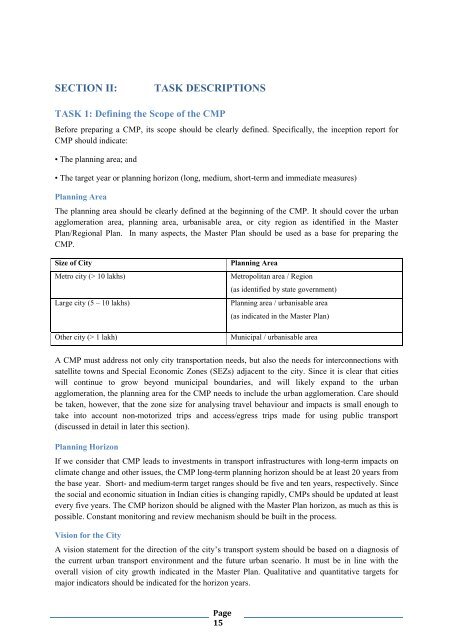Toolkits for Urban Transport Development - UNEP
Toolkits for Urban Transport Development - UNEP
Toolkits for Urban Transport Development - UNEP
Create successful ePaper yourself
Turn your PDF publications into a flip-book with our unique Google optimized e-Paper software.
SECTION II:<br />
TASK DESCRIPTIONS<br />
TASK 1: Defining the Scope of the CMP<br />
Be<strong>for</strong>e preparing a CMP, its scope should be clearly defined. Specifically, the inception report <strong>for</strong><br />
CMP should indicate:<br />
• The planning area; and<br />
• The target year or planning horizon (long, medium, short-term and immediate measures)<br />
Planning Area<br />
The planning area should be clearly defined at the beginning of the CMP. It should cover the urban<br />
agglomeration area, planning area, urbanisable area, or city region as identified in the Master<br />
Plan/Regional Plan. In many aspects, the Master Plan should be used as a base <strong>for</strong> preparing the<br />
CMP.<br />
Size of City<br />
Metro city (> 10 lakhs)<br />
Large city (5 – 10 lakhs)<br />
Other city (> 1 lakh)<br />
Planning Area<br />
Metropolitan area / Region<br />
(as identified by state government)<br />
Planning area / urbanisable area<br />
(as indicated in the Master Plan)<br />
Municipal / urbanisable area<br />
A CMP must address not only city transportation needs, but also the needs <strong>for</strong> interconnections with<br />
satellite towns and Special Economic Zones (SEZs) adjacent to the city. Since it is clear that cities<br />
will continue to grow beyond municipal boundaries, and will likely expand to the urban<br />
agglomeration, the planning area <strong>for</strong> the CMP needs to include the urban agglomeration. Care should<br />
be taken, however, that the zone size <strong>for</strong> analysing travel behaviour and impacts is small enough to<br />
take into account non-motorized trips and access/egress trips made <strong>for</strong> using public transport<br />
(discussed in detail in later this section).<br />
Planning Horizon<br />
If we consider that CMP leads to investments in transport infrastructures with long-term impacts on<br />
climate change and other issues, the CMP long-term planning horizon should be at least 20 years from<br />
the base year. Short- and medium-term target ranges should be five and ten years, respectively. Since<br />
the social and economic situation in Indian cities is changing rapidly, CMPs should be updated at least<br />
every five years. The CMP horizon should be aligned with the Master Plan horizon, as much as this is<br />
possible. Constant monitoring and review mechanism should be built in the process.<br />
Vision <strong>for</strong> the City<br />
A vision statement <strong>for</strong> the direction of the city’s transport system should be based on a diagnosis of<br />
the current urban transport environment and the future urban scenario. It must be in line with the<br />
overall vision of city growth indicated in the Master Plan. Qualitative and quantitative targets <strong>for</strong><br />
major indicators should be indicated <strong>for</strong> the horizon years.<br />
Page<br />
15
















